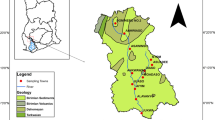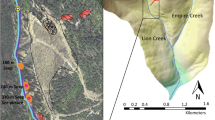Abstract
To assess the potential risk of Mining Influenced Water (MIW) contaminating the “Cradle of Humankind” Unesco World Heritage site (“Fossil Hominid Sites of South Africa”), flow measurements were conducted in the Tweelopiespruit, a stream influenced by treated mine water from abandoned gold mines in the Witwatersrand gold fields (South Africa). A possible negative influence of the caves by MIW infiltrating into the dolostone aquifer was investigated by conducting flow measurements at different stream locations between June 2014 and February 2019 using the salt dilution method via sudden injection (‘gulp method’). Both logging approaches, the manual method using a multi-meter and the automatic device using probes connected to a data-logger, show reasonable and comparable results in the turbulent flow regime. The general flow increases along the course of the Tweelopiespruit rivulet and only minor localized discharge losses can be observed. An immediate danger for the caves of the “Fossil Hominid Sites of South Africa” from infiltrating polluted mine water cannot be postulated, though smaller amounts of the stream water seem to infiltrate into the dolomitic aquifer.










Similar content being viewed by others
References
Ackman TE, Jones JR (1988) Stream sealing to reduce surface water infiltration into underground mines. Bur Mines Inf Circ IC 9183:232–239
Allen CM, Taylor EA (1923) The salt velocity method of water measurements. Trans Am Soc Mech Eng 45:285–341
Bradley C, Cross J, Durand JF, Ellis R, Groenewald J, Grove A, Holland M, Kenyon P, Jamison AA, Krige WG, Macgregor M, Tholin J, Peinke D, Witthüser K, van Biljon M (2010) The Karst System of the Cradle of Humankind World Heritage Site, WRC Report No. KV 241/10. Water Research Commission, Pretoria, p 402
Coetzee H (2011) A flooding and pumping model for the Western Basin of the Witwatersrand Gold Fields, based on empirical data, Report No. Report 2011-0176. Council for Geoscience, Pretoria, p 7
Coetzee H, Horstmann U, Ntsume G, Croukamp L (2003) The potential environmental impact of the decant of water from Witwatersrand. In: Nel PJL (ed) Mine Water Environ. Proceedings 8th International Mine Water Association Congress, Johannesburg, p 201–217
Coetzee H, Kotoane M, Atanasova M, Roelofse F (2013) Interactions between dolomite and acid mine drainage in the Witwatersrand: results of field and laboratory studies and the implications for natural attenuation in the West Rand Goldfield. In: Brown A, Figueroa L, Wolkersdorfer C (eds) Reliable Mine Water Technology. International Mine Water Association, Golden, p 307–312
Day TJ (1976) On the precision of salt dilution gauging. J Hydrology 31:293–306
Day TJ (1977) Field procedures and evaluation of a slug dilution gauging method in mountain streams. J Hydrol New Zealand 16(2):113–133
Department of Water Affairs (2013) Assessment of the water quantity and quality of the witwatersrand mine voids, DWA Report No. P RSA 000/00/16512/2, Johannesburg, p 185
Digby Wells & Associates (Pty) Ltd. Co (2012) Draft Scoping Report for the Immediate and Short Term Interventions for the Treatment of Acid Mine Drainage (AMD) in the Western, Central and Eastern Basins of the Witwatersrand Gold Fields, Report No. DEA Ref 12/1220/2403 Digby Wells & Associates (Pty) Ltd. Co, Randburg, 166 p
Durand JF (2012) The impact of gold mining on the Witwatersrand on the rivers and karst system of Gauteng and North West Province, South Africa. J Afr Earth Sci 68:24–43. https://doi.org/10.1016/j.jafrearsci.2012.03.013
Durand JF, Meeuvis J, Fourie M (2010) The threat of mine effluent to the UNESCO status of the Cradle of Humankind World Heritage Site. TD J Transdiscipl Res S Afr 6(1):73–92
Eriksson GP, Altermann W (1998) An overview of the geology of the transvaal supergroup dolomites (South Africa). Environ Geol 36(1):179–188. https://doi.org/10.1007/s002540050334
Eriksson PG, Altermann W, Hartzer FJ (2006) The transvaal supergroup and its precursors. In: Johnson MR, Anhaeusser CR, Thomas RJ (eds) The geology of South Africa. Council for Geoscience, Pretoria, pp 237–260
Fetter CW (2001) Applied hydrogeology, 4th edn. Prentice Hall, Upper Saddle River
Fischer HB, List EJ, Koh RCY, Imberger J, Brooks NH (1979) Mixing in inland and coastal waters. Academic Press, San Diego
Gees A (1990) Flow measurement under difficult measuring conditions: field experience with the salt dilution method. IAHS AISH Publ 193:255–262
Herschy RW (1995) Streamflow measurement, 3rd edn. Taylor & Francis, Oxon
Hobbs PJ, Cobbing JE (2007) A Hydrogeological Assessment of Acid Mine Drainage Impacts in the West Rand Basin, Gauteng Province, Report No. CSIR/NRE/WR/ER/2007/0097/C. Council for Scientific and Industrial Research Natural Resources & the Environment, Pretoria, p 59
Hobbs PJ, de Meillon N (2017) Hydrogeology of the Sterkfontein cave system, Cradle of Humankind, South Africa. S Afr J Geol 120(3):403–420. https://doi.org/10.25131/gssajg.120.3.403
Hobbs PJ, Mills PJ (2012) Managing the Threats to the Karst Water Resources of the Cradle of Humankind World Heritage Site, South Africa. Paper presented at the Protected karst territories—monitoring and management, Shumen:1–11
Hobbs PJ, Jamison A, Leyland R, Venter J, Roelofse F, Coetzee H, Wade P, Hardwick D, Butler M, Abiye T, Verhagen BT (2011) Situation Assessment of the Surface Water and Groundwater Resource Environments in the Cradle of Humankind World Heritage Site, Report No. Report BIQ005/2008. Council for Scientific and Industrial Research, Council for Geoscience, Wits School of Geoscience, iThemba LABS, A. Jamison, D. Hardwick, Johannesburg, p 238
Holland M, Witthüser KT (2009) Geochemical characterization of karst groundwater in the Cradle of Humankind World Heritage site, South Africa. Environ Geol 57(3):513–524. https://doi.org/10.1007/s00254-008-1320-2
I.S.O.—International Organization for Standardization (1992) Measurement of liquid flow in open channels—Tracer dilution methods for the measurement of steady flow—Part 3: Chemical tracers. vol ISO 9555-3. ISO–—International Organization for Standardization, Genève
I.S.O.—International Organization for Standardization (1994) Measurement of liquid flow in open channels—Tracer dilution methods for the measurement of steady flow—Part 1: General. vol ISO 9555-1. ISO—International Organization for Standardization, Genève
Kite G (1993) Computerized streamflow measurement using slug injection. Hydrol Process 7(2):227–233. https://doi.org/10.1002/hyp.3360070212
Kolver L (2013) Acid Test—Shift from ‘blame seeking’ will aid efforts to tackle SA’s acid mine drainage challenge. Mining Weekly 19:8–31
Krige WG (2006) Hydrological/Chemical Aspects of the Tweelopie-/Riet-/Blaauwbankspruit, with Specific Reference to the Impact Water, Decanting from the Western Basin Mine Void, has on this System, Report. African Environmental Development, Sterkfontein, 64 p
Landesanstalt für Umweltschutz Baden-Württemberg (2002) Durchflussermittlung mit der Salzverdünnungsmethode. Arbeitsanleitung Pegel- und Datendienst Baden-Württemberg [Flow determination with the salt dilution method. Working instruction Pegel- und Datendienst Baden-Württemberg]. Landesanstalt für Umweltschutz Baden-Württemberg, Karlsruhe
Leibundgut C, Małoszewski P, Külls C (2009) Tracers in hydrology. Wiley-Blackwell, Oxford
Leonard L, Langton A (2016) Challenges facing tourist attractions due to acid mine drainage in the West Rand Gauteng. Afr J Hosp Tour Leis 5(1):1–12
Martini JEJ, Wipplinger PE, Moen HFG, Keyser A (2003) Contribution to the speleology of Sterkfontein Cave, Gauteng Province, South Africa. Int J Speleol 32(1):43–69. https://doi.org/10.5038/1827-806X.32.1.4
Mashishi DT, Wolkersdorfer C, Coetzee H (2022) The Whitehill Formation as a natural geochemical analogue to the Witwatersrand Basin’s mine water issues, South Africa. Environ Sci Pollut Res. https://doi.org/10.1007/s11356-021-17699-6
Moore RD (2003) Introduction to salt dilution gauging for streamflow measurement: part 1. Streamline Watershed Manag Bull 7(4):20–23
Moore RD (2005) Introduction to salt dilution gauging for streamflow measurement part 3: slug injection using salt in solution. Streamline Watershed Manag Bull 8(2):1–6
Science Applications International Corporation (2001) Performing Quality Flow Measurements at Mine Sites, Report No. EPA 68-C-98-006. National Risk Management Research Laboratory, Cincinnati, p 78
Shapi M, Jordaan MA, Nadasan DS, Davies TC, Chirenje E, Dube M, Lekoa MR (2020) Analysis of the distribution of some potentially harmful elements (PHEs) in the Krugersdorp game reserve, Gauteng, South Africa. Minerals. https://doi.org/10.3390/min10020151
Stratford D (2015) The Sterkfontein caves: geomorphology and hominin-bearing deposits. In: Grab S, Knight J (eds) Landscapes and landforms of South Africa. Springer, Cham, pp 147–153
Stratford DJ (2018) The Sterkfontein caves after eighty years of paleoanthropological research: the journey continues. Am Anthropol 120(1):39–54. https://doi.org/10.1111/aman.12982
Tlowana S, Coetzee H, Makgae M (2013) Realistic simulation of acid mine drainage generation in the gold mines of the Witwatersrand, South Africa. In: Brown A, Figueroa L, Wolkersdorfer C (eds) Reliable mine water technology. International Mine Water Association, Golden, pp 475–479
Turton A (2015) Managing the unintended consequences of mining: acid mine drainage in Johannesburg. In: Eslamian S (ed) Urban water reuse handbook. CRC Press, pp 551–561
U. S. Department of the Interior—Bureau of Reclamation (2001) Water measurement manual, 3rd edn. U.S. Government Print Office, Washington
Vegter JR (1996) The fountains of Pretoria. Environ Geol 27(2):113–117. https://doi.org/10.1007/bf01061682
Vegter JR, Foster MBJ (1992) The hydrogeology of dolomitic formations in the southern and western Transvaal. Int Contrib Hydrogeol 13:355–376
Wolkersdorfer C (2008) Water management at abandoned flooded underground mines—fundamentals, tracer tests, modelling, water treatment. Springer, Heidelberg
Wood PJ, Dykes AP (2002) The use of salt dilution gauging techniques: ecological considerations and insights. Water Res 36(12):3054–3062. https://doi.org/10.1016/s0043-1354(01)00519-x
van Wyk E, Mokgatle T, de Meillon N (2013) Witwatersrand mine voids—their hydrochemistry and hydrodynamic characteristics. Paper presented at the 13th Biennial Groundwater Division Conference and Exhibition, Durban, p 1–15
Acknowledgements
The authors acknowledge the financial support of the Tshwane University of Technology (TUT), the National Research Foundation (NRF), the South African Research Chair for Mine Water Management, Freunde und Förderer der Technischen Universität Bergakademie Freiberg e.V. and Förderkreis Freiberger Geowissenschaften e.V. Furthermore, we acknowledge S. Du Toit from Mogale City Municipality for his kind support and for providing us with access to the Krugersdorp Game Reserve. Johan Tijssen and his site manager Darrell O’Kelly from the Pinocchio’s Farm allowed us access to their property. Henk Coetzee, Sandile Langa, Corinna Schwarz, Yazeed van Wyk, Phathu Nemaxwi, Olma Makonto, Mokone Mpho Penelope, Lwazi Shongwe and Annike Koekemoer are thanked for supporting and helping us in the field. Mlindelwa Lupankwa, Stephanie Lohmeier and Pieter Coetzee commented on and improved an earlier version of this paper and Garfield Krige provided additional data. Thanks to three anonymous reviewers for their valuable comments and questions.
Funding
Tshwane University of Technology (TUT), National Research Foundation (NRF), Freunde und Förderer der Technischen Universität Bergakademie Freiberg e.V., Förderkreis Freiberger Geowissenschaften e.V.
Author information
Authors and Affiliations
Contributions
CreDiT: funding acquisition: CW; investigation: EM, CW; supervision: CW; writing—original draft: EM; writing—review and editing: CW.
Corresponding author
Ethics declarations
Conflict of interest
All authors certify that they have no affiliations with or involvement in any organization or entity with any financial interest or non-financial interest in the subject matter or materials discussed in this manuscript.
Additional information
Publisher’s Note
Springer Nature remains neutral with regard to jurisdictional claims in published maps and institutional affiliations.
Rights and permissions
About this article
Cite this article
Mugova, E., Wolkersdorfer, C. Identifying potential groundwater contamination by mining influenced water (MIW) using flow measurements in a sub-catchment of the “Cradle of Humankind” Unesco World Heritage Site, South Africa. Environ Earth Sci 81, 104 (2022). https://doi.org/10.1007/s12665-022-10224-z
Received:
Accepted:
Published:
DOI: https://doi.org/10.1007/s12665-022-10224-z




